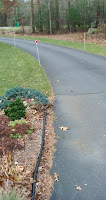We observed one of our solemn, annual rituals the other day: we put out the driveway markers.
We have fairly well exhausted the end-of-fall checklist. The leaves have been mowed and re-mowed into the lawn until they are a fine, brown mulch. The perennial beds have been cut flat and, depending upon whether the spindly, desiccated stalks showed evidence of mildew or not, the detritus has been either composted or taken to the dump.
Those autumn chores remind us that, once upon a time, there was color and life in our garden. By contrast, putting out the driveway markers serves only the purpose of acknowledging that winter is imminent. The sun will set today at 4:15, the third of an eleven-day run featuring that horrendously early departure of daylight. It rose this morning at 7:01 and, incredibly, has still another ten minutes of daylight to lose before the solstice. With just nine hours of daylight and nighttime temperatures sinking into the low twenties, all it will take is a little bit of moisture coming up from the Gulf of Mexico and the snows of winter will arrive with a vengeance.
The markers look odd for now; circles of bright red atop white poles. Because our driveway meanders 220 feet from the street to the garage (good feng shui, I imagine) and has a curving turnaround area, it takes 20 markers to indicate the true outline of the course. It’s a necessary exercise: not for the first snow but, rather, for the fourth or fifth. The first one (unless it’s a nor’easter) will melt in a day. The second one may linger a little longer but the demarcation between asphalt and lawn will still be obvious even under a few inches of snow.
It’s when we get six inches of snow followed by eight inches more that the reason for the markers becomes clear. The person pushing the snow blower follows the line of markers, left and right, throwing snow between two feet and ten depending upon how much moisture is in it (if you are a snow-shoveling veteran, you can skip this part). In wide areas of a driveway or where the house or shrubs are immediately adjacent, snow is thrown elsewhere on the driveway, then re-blown off on a subsequent pass. Each pass deposits snow in a slightly different location with the result that after a short while there is no longer a clear line between driveway and non-driveway. Without those markers as a guide, a snow blower will inevitably veer off into grass. The blades of the snow blower grind up the grass, killing it, while also typically snapping a shear pin. By mid-January, those markers are worth their weight in hot chocolate.
We also are sticklers for cleaning right to the edge of the driveway. This is a matter of personal preference for some New Englanders (I have seen driveways plowed exactly the width of a car and not an inch more). Betty’s strongly held view is that snow or ice left on a driveway is bound to melt and re-freeze. Getting it all off as soon as it snows is the one way to keep the driveway clear all winter.
And, it all starts with those markers. And the markers start now, in early December.
December 6, 2010
Subscribe to:
Post Comments (Atom)



No comments:
Post a Comment